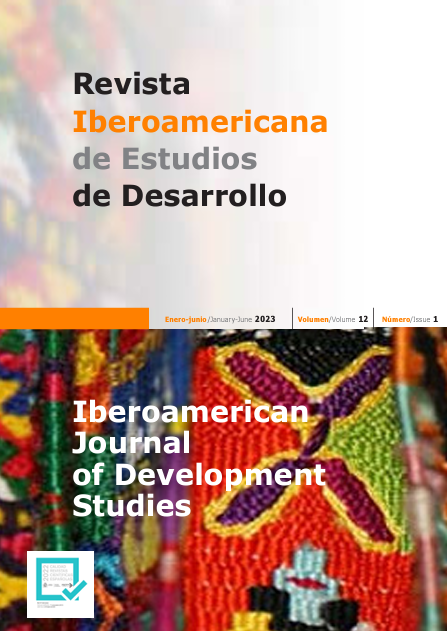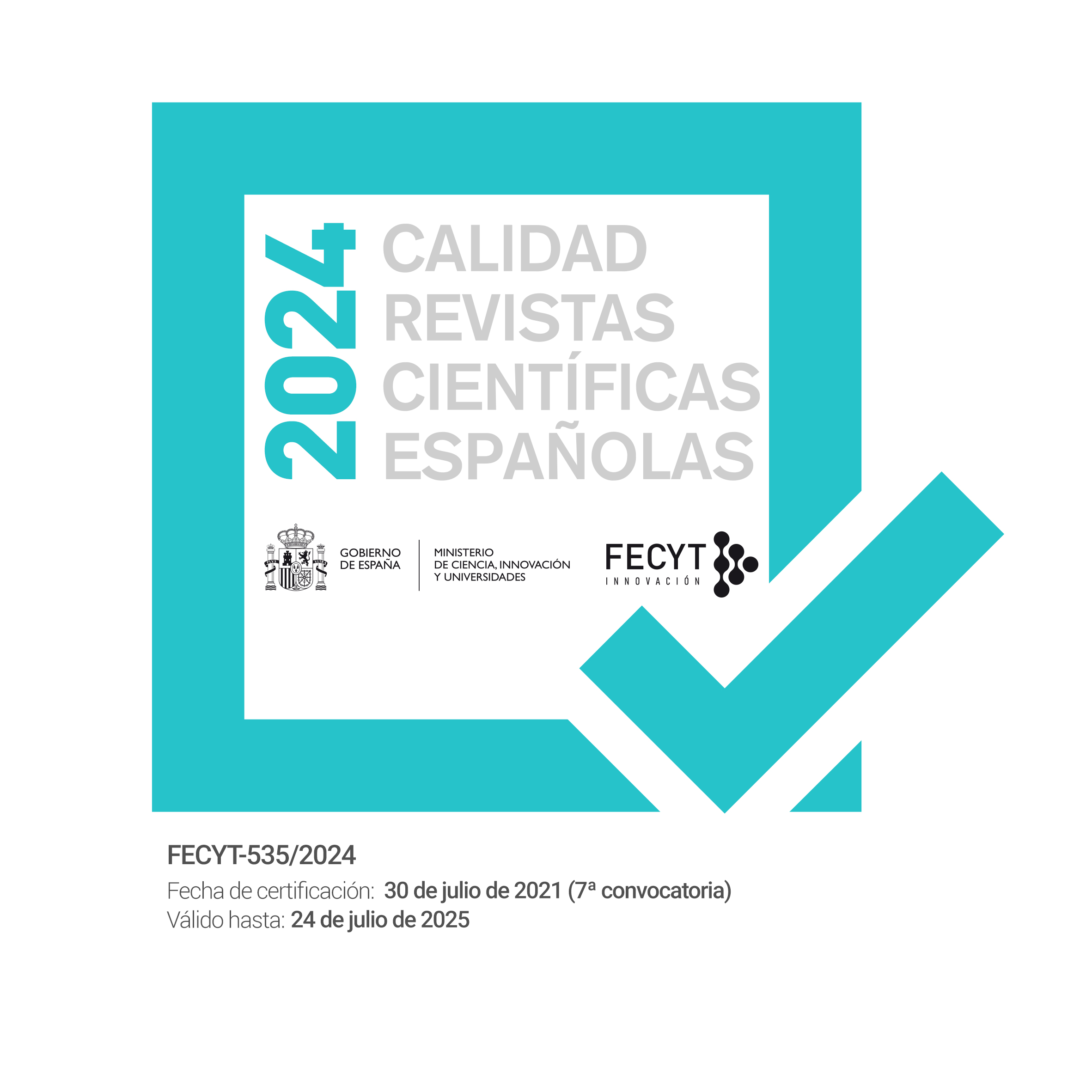What changes the skill premium in South America?
DOI:
https://doi.org/10.26754/ojs_ried/ijds.698Palabras clave:
desigualdad, prima por habilidad, gobernanza, capital humano, productividadResumen
En este artículo, se analiza qué variables limitan la reducción de la desigualdad en Sudamérica, medida por la prima por habilidad, en el período de estancamiento económico de 2016-2019. Se consideran, para ello, las variables con las que se explica en la región su disminución en 2002-2015 y se aplica un modelo de Probit ordenado generalizado para identificar cuáles estarían limitando su reducción en 2016-2019. En los resultados, se muestra que la gobernanza, el capital humano y la productividad son las dimensiones que más inciden en la capacidad de los países de la región para reducir su prima por habilidad.
Descargas
Referencias
ACOSTA P, GASPARINI L (2007). Capital accumulation, trade liberalization, and rising wage inequality: the case of Argentina. Economic Development and Cultural Change 55(4):793-812.
AFONSO O, GIL PM (2013). Effects of North-South trade on wage inequality and on human-capital accumulation. Economic Modelling 35:481-492.
ALANIZ E, ESPINO A, GINDLING T (2019). Self-employment and labour market dynamics of men and women in El Salvador and Nicaragua (No. 2019/97). WIDER Working Paper.
ALANIZ E, GINDLING TH, TERRELL K (2011). The impact of minimum wages on wages, work and poverty in Nicaragua. Labour Economics 18:S45-S59.
ALEJO J, PARADA C (2017). Inequality and Informality in Latin America: The Case of Brazil. Desarrollo y Sociedad (78):143-199.
ALEJO OJ, BERGOLO SOSA ML, CARBAJAL ESPINAL F (2014). Las transferencias públicas y su impacto distributivo: la experiencia de los países del Cono Sur en la década de 2000.
ALVAREDO F, GASPARINI L (2015). Recent trends in inequality and poverty in developing countries. Handbook of Income Distribution 2:697-805.
ALVES G, AMARANTE V, SALAS G, VIGORITO A (2012). La desigualdad del ingreso en Uruguay entre 1986 y 2009. Serie Documentos de Trabajo/FCEA-IE; DT03/12.
ARANGO CAA, PACHÓN A (2004). Minimum Wages in Colombia: Holding the Middle with a Bite on the Poor. Colombia: Banco de la República.
ASTORGA P (2017). Real wages and skill premiums in Latin America, 1900-2011. Revista de Historia Económica-Journal of Iberian and Latin American Economic History 35(3):319-353.
AZEVEDO J, INCHAUSTE G, SANFELICE V (2013). Decomposing the Recent Inequality Decline in Latin America. Policy Research Working Paper 6715. https://doi.org/10.1596/1813-9450-6715, acceso 12-20 de octubre de 2021.
AZEVEDO JP, DÁVALOS ME, DÍAZ-BONILLA C, ATUESTA B, CASTAÑEDA RA (2013). Fifteen years of inequality in Latin America: how have labor markets helped? Policy Research Working Paper Series 6384.
BANCO DE DESARROLLO DE AMÉRICA LATINA (2016). Más habilidades para el trabajo y la vida: los aportes de la familia, la escuela, el entorno y el mundo laboral. RED.
BANERJEE AV, COLE S, DUFLO E, LINDEN L (2007). Remedying education: Evidence from two randomized experiments in India. The Quarterly Journal of Economics 122(3):1235-1264.
BÁRCENA A, PRADO A, ABRAMO L, PÉREZ R (2016a). Inclusive social development: The next generation of policies for overcoming poverty and reducing inequality in Latin America and the Caribbean. Economic Commission for Latin America and the Caribbean.
BÁRCENA A, PRADO A, ABRAMO L, PÉREZ R (2016b). The social inequality matrix in Latin America. Economic Commission for Latin America and the Caribbean, November. https://repositorio.cepal.org/bitstream/handle/11362/40710/S1600945_en.pdf?sequence=1&isAllowed=y , acceso 12-20 de octubre de 2021.
BENABOU R (1994). Human capital, inequality, and growth: A local perspective. European Economic Review 38(3-4):817-826.
BERNIELL L (2020). Occupational Choice and Investments in Human Capital in Informal Economies. The BE Journal of Macroeconomics, 1(ahead-of-print).
BEYER H (2005). Productividad, desigualdad y capital humano: los complejos desafíos de Chile. Estudios Públicos 97:59-98.
BRESNAHAN TF, BRYNJOLFSSON E, HITT LM (2002). Information technology, workplace organization, and the demand for skilled labor: firm-level evidence. The Quarterly Journal of Economics 117(1):339-376.
BRYNJOLFSSON E, HITT LM (2000). Beyond computation: information technology, organizational transformation and business performance. Journal of Economic Perspectives 14(4):23-48.
BUSSO M, CRISTIA J, HINCAPIÉ D, MESSINA J, RIPANI L (2017). Learning better: public policy for skills development. Inter-American Development Bank.
CAÑONERO G, WERNER A (2002). Salarios relativos y liberación del comercio en México. El Trimestre Económico:123-142.
CARRILLO PE, ONOFA M, PONCE J (2011). Information Technology and Student Achievement: Evidence from a Randomized Experiment in Ecuador.
CORSEUIL CH, FOGUEL M, HECKSHER M (2015). Efeitos dos pisos salariais estaduais sobre o mercado de trabalho: uma nova abordagem empírica. Economia Aplicada 19(1):131-169.
COWEN T (2014). How technology could help fight income inequality. New York Times 6.
DE LA FUENTE A (2011). Human capital and productivity. Nordic Economic Policy Review 2(2):103-132.
DE LA TORRE A, MESSINA J, PIENKNAGURA S (2012). The labor market story behind Latin America’s transformation. The World Bank.
DE LA TORRE A, MESSINA J, SILVA J (2017). The inequality story in Latin America and the Caribbean: searching for an explanation. In: Has Latin American Inequality Changed Direction?: Looking over the Long Run. https://doi.org/10.1007/978-3-319-44621-9_13, acceso 12-20 de octubre de 2021.
DOERINGER PB, PIORE MJ (1985). Internal labor markets and manpower analysis. Me Sharpe.
ESQUIVEL G, RODRÍGUEZ-LÓPEZ JA (2003). Technology, trade, and wage inequality in Mexico before and after NAFTA. Journal of Development Economics 72(2):543-565.
FAIRLIE RW (2005). The effects of home computers on school enrollment. Economics of Education Review 24(5):533-547.
FERNÁNDEZ M, MESSINA J (2018). Skill premium, labor supply, and changes in the structure of wages in Latin America. Journal of Development Economics 135:555-573. https://doi.org/10.1016/j.jdeveco.2018.08.012, acceso 12-20 de octubre de 2021.
FERREIRA FHG, FIRPO SP, MESSINA J (2017). Ageing Poorly? Accounting for the decline in earnings inequality in Brazil, 1995-2012. The World Bank.
FERREIRA FHG, LEITE PG, WAI-POI M (2007). Trade liberalization, employment flows and wage inequality in Brazil (Issue 2007/58). WIDER Research Paper.
FORESTS R (2018). UC Business Analytics R Programming Guide. University of Cincinnati.
GALIANI S, SANGUINETTI P (2003). The impact of trade liberalization on wage inequality: evidence from Argentina. Journal of Development Economics 72:497-513.
GALIANI S, HEYMAN D, MAGUD NE (2010). On the Distributive Effects of Terms of Trade Shocks: The Role of Non-Tradable Goods. IMF Working Papers 10(241):1. https://doi.org/10.5089/9781455209415.001, acceso 12-20 de octubre de 2021.
GASPARINI L, LUSTIG N (2011). The Rise and Fall of Income Inequality in Latin America. Oxford University Press. https://doi.org/10.1093/oxfordhb/9780199571048.013.0027, acceso 12-20 de octubre de 2021.
GASPARINI L, LUSTIG N (2012). The Rise and Fall of Income Inequality in Latin America. In The Oxford Handbook of Latin American Economics. https://doi.org/10.1093/oxfordhb/9780199571048.013.0027, acceso 12-20 de octubre de 2021.
GASPARINI L, CRUCES G, ACOSTA P, GALIANI S (2011). Educational upgrading and returns to skills in Latin America: evidence from a supply-demand framework, 1990-2010. World Bank Policy Research Working Paper 5921.
GINDLING TH, TERRELL K (2010). Minimum wages, globalization, and poverty in Honduras. World Development 38(6):908-918.
GONZAGA G, MENEZES-FILHO N, TERRA MC (2002). Earnings Differentials and Trade Liberalization in Brazil. Fundacão Getúlio Vargas, Mimeo.
GRAU N, LANDERRETCHE MORENO Ó (2011). The Labor Impact of MWs: A Method for Estimating the Effect in Emerging Economies Using Chilean Panel Data.
GREENE WH, HENSHER DA (2010). Modeling Ordered Choices: A Primer. Cambridge University Press.
GUERRA‐SALAS JF (2018). Latin America’s declining skill premium: a macroeconomic analysis. Economic Inquiry 56(1):620-636.
HANUSHEK EA, WOESSMANN L (2011). How much do educational outcomes matter in OECD countries? Economic Policy 26(67):427-491.
HELFAND SM, ROCHA R, VINHAIS H (2009). Pobreza e desigualdade de renda no Brasil rural: uma análise da queda recente.
HERR H (2009). The labour market in a Keynesian economic regime: theoretical debate and empirical findings. Cambridge Journal of Economics 33(5):949-965.
INCHAUSTE G, AZEVEDO JP, ESSAMA-NSSAH B, OLIVIERI S, VAN NGUYEN T, SAAVEDRA-CHANDUVI J, WINKLER H (2014). Understanding Changes in Poverty. In Understanding Changes in Poverty. https://doi.org/10.1596/978-1-4648-0299-7, acceso 12-20 de octubre de 2021.
INTERNATIONAL LABOR ORGANIZATION (ILO) (1972). Employment, Incomes and Equality: A Strategy for Increasing Productive Employment in Kenya. ILO, Geneva.
INTERNATIONAL MONETARY FUND (IMF) (2019). World Economic Outlook: Growth Slowdown, Precarious Recovery. April, Washington, DC.
IZQUIERDO A, LLOPIS J, MURATORI U, RUIZ J (2016). In search of larger per capita incomes: How to prioritize across productivity determinants?
KATOVICH ES, MAIA AG (2018). The relation between labor productivity and wages in Brazil. Nova Economia 28(1):7-38.
KATZ LF, MURPHY KM (1992). Changes in Relative Wages, 1963-1987: Supply and Demand Factors. The Quarterly Journal of Economics 107(1):35-78. https://doi.org/10.2307/2118323, acceso 12-20 de octubre de 2021.
KHARLAMOVA G, STAVYTSKYY A, ZAROTIADIS G (2018). The impact of technological changes on income inequality: the EU states case study. Journal of International Studies 11(2).
LUSTIG N, LÓPEZ-CALVA LF, ORTIZ-JUÁREZ E (2013). Deconstructing the Decline in Inequality in Latin America. The World Bank. https://doi.org/10.1596/1813-9450-6552, acceso 12-20 de octubre de 2021.
MAGUD NE, COBLE FERNÁNDEZ DO (2010). A Note on Terms of Trade Shocks and the Wage Gap. SSRN Electronic Journal. https://doi.org/10.2139/ssrn.1751391, acceso 12-20 de octubre de 2021.
MAKLES A (2012). Stata tip 110: how to get the optimal k-means cluster solution. The Stata Journal 12(2):347-351.
MALONEY WF, NUNEZ J (2000). Measuring the Impact of Minimum Wages: Evidence from Latin America. The World Bank.
MANACORDA M, SÁNCHEZ-PÁRAMO C, SCHADY N (2010). Changes in returns to education in Latin America: the role of demand and supply of skills. In Industrial and Labor Relations Review. https://doi.org/10.1177/001979391006300207, acceso 12-20 de octubre de 2021.
MARTÍNEZ H (2006). Métodos numéricos y álgebra lineal. Tecnológico de Monterrey.
MAURIZIO R (2014). Labour formalization and declining inequality in Argentina and Brazil in 2000s: a dynamic approach. ILO Research Paper 9.
MESSINA J, SILVA J (2018). Wage Inequality in Latin America. Understanding the Past to Prepare the Future.
NAJARZADEH R, RAHIMZADEH F, REED M (2014). Does the Internet increase labor productivity? Evidence from a cross-country dynamic panel. Journal of Policy Modeling. https://doi.org/10.1016/j.jpolmod.2014.10.003, acceso 12-20 de octubre de 2021.
NEUMARK D, CUNNINGHAM W, SIGA L (2006). The effects of the minimum wage in Brazil on the distribution of family incomes: 1996-2001. Journal of Development Economics 80(1):136-159.
NOGALES R, CÓRDOVA P, URQUIDI M (2019). Resultados en el mercado de trabajo y políticas laborales en Bolivia: un enfoque de búsqueda y emparejamiento. Estudios de economía 46(1):61-87.
OECD (2004). The Economic Impact of ICT. Measurement, Evidence and Implications.
OLARTE SH, SOSA FV (2020). How does the worker’s contribution to productivity explain the decrease in inequality in South America? GCG: revista de globalización, competitividad y gobernabilidad 14(2):84-104.
OLARTE SH, VILLARREAL F, TORRENT J (2021). Is productive capacity a key factor to reduce inequalities in South America? Development Studies Research 8(1):94-108.
PAVCNIK N (2003). What explains skill upgrading in less developed countries? Journal of Development Economics 71(2):311-328.
ROBERTSON R (2004). Relative prices and wage inequality: evidence from Mexico. Journal of International Economics 64(2):387-409.
SAGET C (2001). Poverty reduction and decent work in developing countries: do minimum wages help? International Labour Review 140(3):237-269. https://doi.org/10.1111/j.1564-913x.2001.tb00532.x, acceso 12-20 de octubre de 2021.
SCHULTZ TW (1961). Investment in Human Capital. American Economic Association 51(5):1035-1039.
SOON J-J (2010). The determinants of students’ return intentions: a partial proportional odds model. Journal of Choice Modelling 3(2):89-112.
SYAKUR MA, KHOTIMAH BK, ROCHMAN EMS, SATOTO BD (2018). Integration k-means clustering method and elbow method for identification of the best customer profile cluster. IOP Conference Series: Materials Science and Engineering 336(1):12017.
TSOUNTA E, OSUEKE A (2014). What is Behind Latin America’s Declining Income Inequality? IMF Working Papers, 14(124):1. https://doi.org/10.5089/9781498378581.001, acceso 12-20 de octubre de 2021.
TURCOTTE J, RENNISON LW (2004). Productivity and wages: measuring the effect of human capital and technology use from linked employer-employee data. Department of Finance.
VAN DER HOEVEN R, RODGERS G (1995). Poverty reduction and development strategy. En: Rodgers G, Van der Hoeven R (eds.). New Approaches to Poverty Analysis and Policy III. The Poverty Agenda:Trends and Policy Options. International Institute for Labor Studies Publications, Switzerland, pp. 1-8.
WILLIAMS R (2006). Generalized ordered logit/partial proportional odds models for ordinal dependent variables. The Stata Journal 6(1):58-82.
WORLD BANK (1995). World development report 1995: Workers in an integrating world. The World Bank.
WORLD BANK (2020). Gini index.
ZHANG J (2005). Income ranking and convergence with physical and human capital and income inequality. Journal of Economic Dynamics and Control 29(3):547-566.
Descargas
Publicado
Número
Sección
Licencia
Derechos de autor 2023 Susana Herrero-Olarte, Christopher Rivadeneira-Cornejo

Esta obra está bajo una licencia internacional Creative Commons Atribución-NoComercial-SinDerivadas 4.0.






